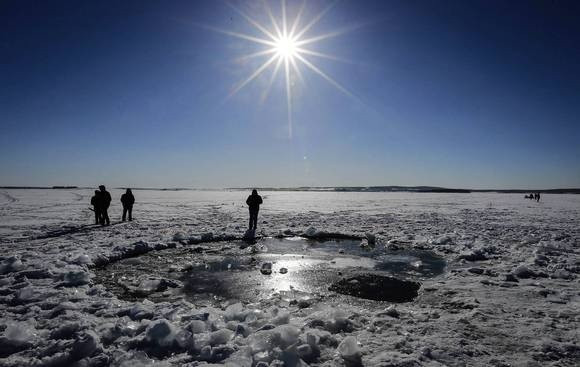Collectors Flock to Central Russia to Hunt Meteor Gold

Forty-eight hours after a 10,000-tonne meteor crashed into the Russian Urals causing 1,200 casualties, crowds of 'meteorite hunters' have flocked to the site in a scramble for fragments of extra-terrestrial treasure.
Rescue teams numbering 20,000 people have been sent to the area, after President Vladimir Putin ordered work to start on the clean-up operation.
But residents of Chelyabinsk and the nearby town of Chebarkul, about 1,000 miles east of Moscow, said an influx of people had come seeking fragments around the 26ft-wide crater site, in the middle of a frozen lake.
Prospective buyers posted wanted ads online, with one hopeful buyer offering more than £10,000 ($15,500) for a piece of cosmic rock.
"The web is awash with people saying they want to buy this stuff," said Chelyabinsk resident Oleg Karpov. "Maybe this thing was not that bad after all if a few of us make some money out of it."
The 55ft-long meteor, the largest to hit the planet in a century, crashed into Chelyabinsk with a force of 500 kilotons, around 30 times that of the atomic bomb dropped on Hiroshima.
The impact shattered windows across an area of 50 acres, equivalent to 33 football pitches, and caused an estimated £21 million ($32.6m) of damage. In Chelyabinsk, some 3,000 buildings were damaged.
Space agency Nasa said the meteor entered the earth's atmosphere at 44,000mph and broke up between 12 and 15 miles above the ground. It was the largest strike since a meteor exploded over the Tunguska river in Siberia in 1908.
Astronomer Phil Plait, the author of Death From The Skies, said fragments of meteor could fetch a high price.
"Having fragments from a known fall - and one with so much amazing footage and drama - means collectors will be all over this," he said.
However, another collector urged caution, saying: "The value of fragments depends entirely on what they are made of. They could be valuable or could be worthless."
A 9in piece of the Seymchan meteorite found in Siberia in 1960 sold for £28,200 ($43,000) in New York last October.
A fragment of meteor found at Dar al Gani in Libya fetched a record £213,000 (then $348,000) in 1998, while Moroccan nomads collected fragments of meteorite in 2011 valued at £113,000 ($175,000).
© Copyright IBTimes 2025. All rights reserved.




















